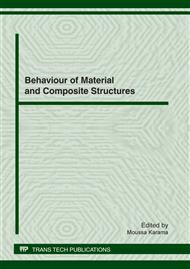p.79
p.89
p.102
p.115
p.126
p.139
p.151
p.161
p.173
Fatigue Crack Growth on FSW AA2024-T3 Aluminum Joints
Abstract:
Friction stir welding (FSW) is a solid-state joining process which emerged as an alternative technology to join high strength alloys that were difficult to weld with conventional techniques, [1]. Developments of this technique are being driven by aeronautic, aerospace and railway industries. An advantage of this joining technique is its low heat input when compared with arc welding processes. This feature allows the achievement of high mechanical properties, low distortion and low residual stresses, [2]. Also, since it is a solid-state welding process, hydrogen cracking or heat affected zone (HAZ) softening phenomena are limited. This paper presents a study of fatigue crack growth behaviour of friction stir welded butt joints of AA2024-T3, aluminium commonly used in riveted aeronautic fuselage structures. Crack growth studies are often carried out using uniform thickness joints, ASTM E647 [3]. Nevertheless, for some applications there is a need to join components with different thicknesses, which, under certain limits, can be welded using FSW. Crack growth tests on these joints are not standard. The present study concerns butt joints made using two plates with different thicknesses, 3.8mm and 4.0mm. The joints’ mechanical behaviour was studied performing static (tensile) and fatigue tests. The fatigue crack growth rate of cracks growing in different zones of the welded joint (nugget, heat affected zone - HAZ) and in base material was analysed. The microhardness profile was assessed in order to analyse the influence of the welding process in each weld zone. Further to higher static properties, welded joints present lower crack growth rate when compared with its base material.
Info:
Periodical:
Pages:
126-138
Citation:
Online since:
January 2012
Price:
Сopyright:
© 2012 Trans Tech Publications Ltd. All Rights Reserved
Share:
Citation:


